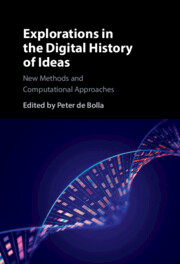Book contents
- Explorations in the Digital History of Ideas
- Explorations in the Digital History of Ideas
- Copyright page
- Contents
- Figures
- Tables
- Contributors
- Acknowledgements
- Part I Computational Methodologies for the History of Ideas
- 1 Introduction
- 2 Distributional Concept Analysis and the Digital History of Ideas
- 3 Operationalising Conceptual Structure
- Part II Case Studies in the Digital History of Ideas
- Index
3 - Operationalising Conceptual Structure
from Part I - Computational Methodologies for the History of Ideas
Published online by Cambridge University Press: 09 November 2023
- Explorations in the Digital History of Ideas
- Explorations in the Digital History of Ideas
- Copyright page
- Contents
- Figures
- Tables
- Contributors
- Acknowledgements
- Part I Computational Methodologies for the History of Ideas
- 1 Introduction
- 2 Distributional Concept Analysis and the Digital History of Ideas
- 3 Operationalising Conceptual Structure
- Part II Case Studies in the Digital History of Ideas
- Index
Summary
This chapter investigates and tests the methodological choices that must be made when creating a conceptual network visualisation from a large text corpus. We often discuss the architecture of complex concepts using metaphors that suggest networked representations. We might speak of a ‘constellation’ or ‘skeleton’ of elementary concepts that has a core, a periphery and sections that are mutually supportive or interlocking. Underlying this metaphor is the notion that concepts are composed of structured associations among many elements, building from words to tightly formed clusters of words to large interlocking architectural forms that give rise to abstract concepts. To build such a network from language, we must operationalise several informal notions, including word association strength, connection thresholds and the total size of the network. This chapter discusses the process of constructing and testing these methods, illustrating the trade-offs and implications of different implementations used when building visualisations of conceptual networks built from lexical co-occurrence data. When the calculations that operationalise the notions of word association and conceptual relation are laid out in detail, it becomes apparent that the choice of implementation cannot be separated from the substantive or theoretical kind of conceptual structure that we aim to capture.
- Type
- Chapter
- Information
- Explorations in the Digital History of IdeasNew Methods and Computational Approaches, pp. 54 - 76Publisher: Cambridge University PressPrint publication year: 2023



